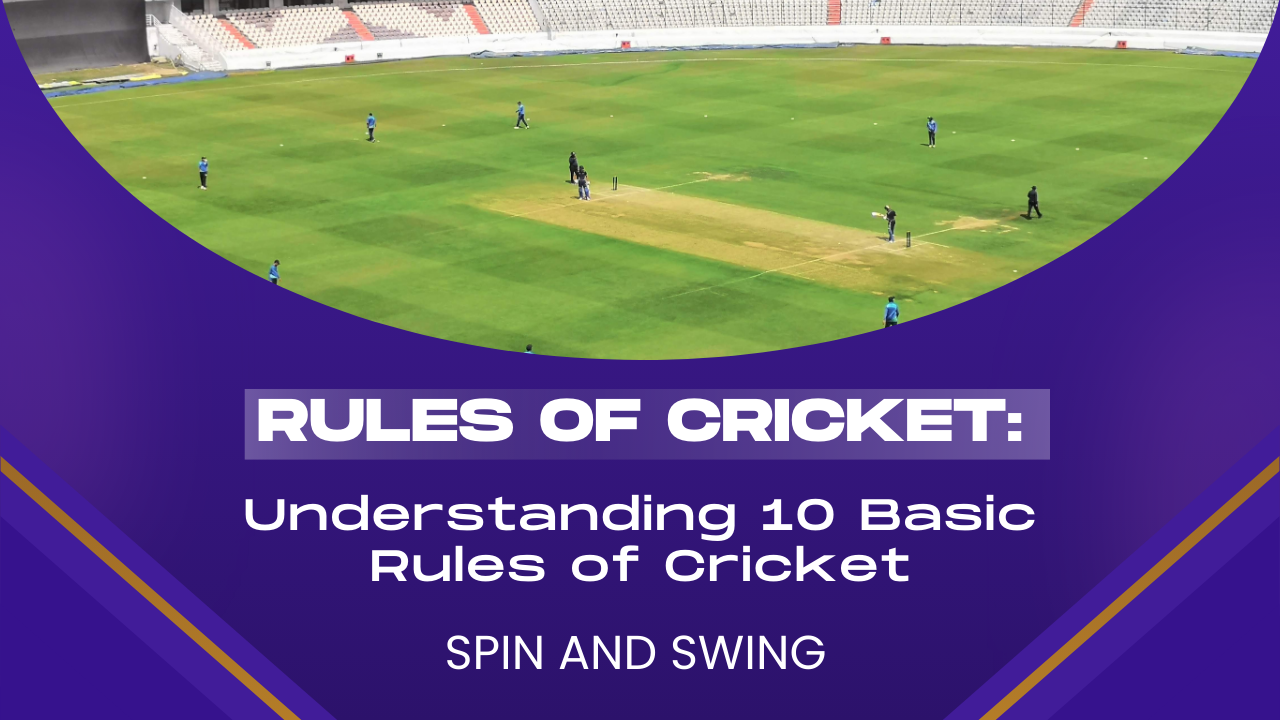The cricket game is loved by millions all over the world, bringing people from all backgrounds and ages. If you are beginning to better understand the sport having a basic understanding of the basic rules of cricket is required. The basic rules of cricket help to clarify the rules of play along with the scoring system and game structure, which makes watching as well as playing the game more fun and enjoyable.
10 Basic Rules of Cricket:

Let’s go over 10 basic rules of cricket to help you better understand the details of this exciting game.
1. The Objective of the Game
The main objective of cricket is straightforward: outscore the opposing team. Teams alternate between batting and bowling (fielding). The batting side seeks to get runs by striking the ball, while the bowling side focuses on restricting runs and getting the batters out.
2. Team Composition
Cricket is a game played between two teams, each comprising 11 players. These teams include batters, bowlers, all-rounders, and a wicketkeeper. While the roles are adaptable, each player plays a crucial part in either getting runs or stopping the opposing team from doing so during their respective turns.
3. The Pitch and Wickets
The game is played on a 22-yard-long pitch, with three wooden stumps called wickets placed at either end. The bowler aims to hit these wickets while the batter defends them with their bat. Wickets play a key role in the release of players.
4. Overs and Bowling
Each innings is divided into overs, with an over consisting of six legal deliveries bowled by a bowler. A bowler cannot bowl consecutive overs. In limited-overs cricket, such as ODIs (50 overs per team) or T20s (20 overs per team), the number of overs per team is fixed, adding excitement as batters aim to maximize runs within the allocated overs.
5. Scoring Runs
Runs are scored in multiple ways:
- Hitting the Ball: A batter hits the ball and runs between the wickets. Each successful run adds to the team’s total.
- Boundaries: If the ball crosses the boundary without touching the ground, it’s a six. If it touches the ground first, it’s a four.
- Extras: Runs can also be added through wides, no-balls, byes, and leg-byes.
6. Ways to Get Out
Releases are critical to cricket, with bowlers and fielders working together to remove batters. Here are some common methods:
- Bowled: The bowler delivers the ball and strikes the stumps.
- Caught: The batter’s shot is caught by a fielder before the ball touches the ground.
- Run Out: A batter fails to reach the crease before the ball hits the stumps.
- LBW (Leg Before Wicket): The ball hits the batter’s leg in line with the stumps, and the umpire rules it would have hit the stumps.
- Stumped: The wicketkeeper removes the bails when the batter steps out of the crease.
Fielding Restrictions
To make the game balanced and strategic, cricket has fielding restrictions:
- In limited-overs cricket, certain rules like Powerplays restrict the number of fielders outside the inner circle. This encourages batters to take risks and score runs.
- In Test cricket, the fielding positions are less restrictive, allowing captains to set unique placements.
8. Umpires and Decision-Making
The game is managed by two on-field umpires who make decisions on outs, scoring, and applying the rules. Modern cricket includes technology with tools like DRS (Decision Review System), which allows teams to question an umpire’s decision using video replays and ball-tracking.
9. Formats of the Game
Cricket is played in three main formats:
- Test Cricket: Played over five days, this format highlights constancy and strategy. Each team has two innings.
- ODIs (One Day Internationals): Limited to 50 overs per team, ODIs balance strategy with faster gameplay.
- T20s (Twenty20): The shortest format, with each team playing 20 overs. T20s focus on high-energy, quick action, and aggressive play.
10. Spirit of the Game
Beyond the technicalities, cricket highlights sportsmanship and fair play. Players are expected to respect the umpires, opponents, and the game itself. This principle is famously referred to as the “Spirit of Cricket”, promoting mutual respect on and off the field.
Trending Insights into Cricket Rules

While the rules of the cricket game remain consistent, modern cricket has introduced some fascinating trends and updates:
- Free Hit Rule: In limited-overs cricket, a bowler who bowls a no-ball gives the batter a “free hit” for the next delivery. The batter cannot be dismissed in most ways, making it a high-scoring opportunity.
- Super Over: If a limited-overs match ends in a tie, teams play a Super Over—a single over per team to decide the winner. This thrilling addition has charmed fans worldwide.
- Power Surge in T20s: Introduced in some leagues, this allows teams to opt for additional Powerplay overs, giving batters more chances to score quickly.
- Player Substitutions: Some leagues now permit strategic replacements, adding a new layer of strategy to team composition.
Why Learning the Rules Matters
Knowing the basic rules of cricket enhances your experience as a player or viewer. For example:
- When you understand fielding restrictions, you’ll appreciate the strategies behind a fielder’s placement.
- Familiarity with the ways to get out helps you grasp the risks batters take during aggressive play.
- Recognizing the importance of Powerplays in limited-overs cricket gives insight into why teams bat or bowl a certain way.
Whether you’re new to cricket or already a fan, these 10 basic rules of cricket ensure you’re well-equipped to enjoy the game and engage in meaningful discussions about its strategies and moments.
Conclusion
Cricket’s charm lies in its mixture of tradition and innovation. By understanding the rules of cricket game, you’ll not only appreciate its legacy but also stay updated with its modern trends. From the enduring Test format to the excitement of T20s, cricket continues to inspire millions around the globe. Stay connected with Spin and Swing for the latest updates on IPL, international cricket, and everything in between. Visit our website for in-depth analysis, match highlights, and expert insights to keep you informed and engaged with the world of cricket!
FAQs
What are the rules of cricket?
The rules of cricket guide how teams play, score, and win the game while maintaining fairness.
What are the 10 basic rules of cricket?
The 10 basic rules include team composition, pitch details, scoring runs, dismissals, overs, fielding, and umpiring.
What are the cricket basic rules?
The basic rules of cricket include scoring runs, protecting the wickets, and following the overs limit.
How many overs are in a cricket match?
Overs depend on the format, with 20 overs in T20s, 50 in ODIs, and unlimited in Tests.
What is the role of the umpire in cricket?
Umpires make decisions on dismissals, scoring, and rules during the game.



